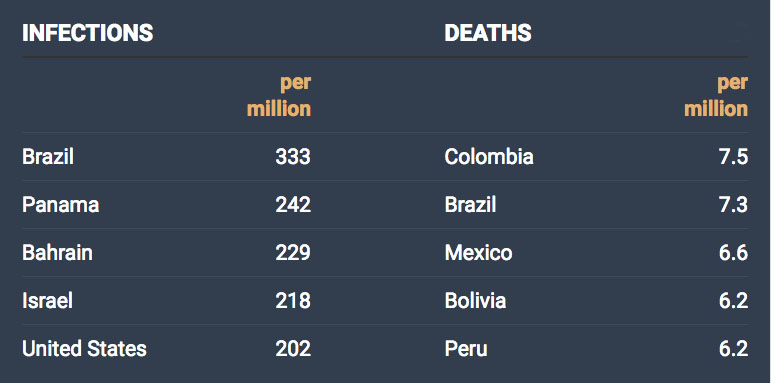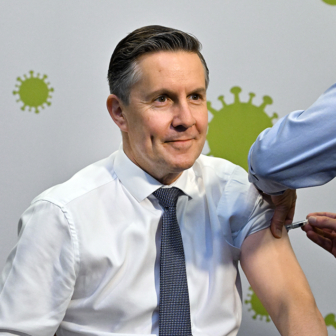If Victoria were a country, today’s data, on a per capita basis, would put it in the top twenty countries in the world for new cases of Covid-19 — and for new deaths from the virus.
That’s how bad these numbers are. The 723 new cases the state reported on Thursday equate to 110 new cases per million people (or 104 in net terms, after correcting for earlier mistaken diagnoses). The thirteen new deaths amount to two for every million people.
Among countries with more than a million people, the global figures published by Worldometers show Brazil is the country where coronavirus is most rampant. On Wednesday it reported 333 new cases per million people, implying that on Tuesday alone, one in every 3000 people in Brazil was diagnosed with the virus. Victoria is not as bad as that, but it has entered that ballpark.
Colombia just pipped Brazil as the country where the virus did most harm on Tuesday, with 7.5 deaths per million people. All these numbers jump around — over the past twelve days, on average, Bahrain has been the top global hotspot for new infections, and Panama for new deaths from the virus. But if Victoria were a country, Thursday’s figures would put it among the twenty worst in the world.
The worst infection and death rates reported around the world yesterday were:

The United States and Israel were the only developed countries with higher infection rates than Victoria reported today. The United States, with four deaths per million people, was the only developed country with a higher death rate.
Had all the local commentariat who berated Sweden for trying a different path focused on where Sweden’s deaths were occurring, they would have seen something more useful for us than point scoring. Sweden recorded very high death rates between April and June largely because it failed to protect its aged care homes. Since then, it has gradually done so, and got on top of the virus in other ways; its current infection and death rates have been well below Victoria’s.
Had we been more alert to the lessons from outbreaks in the rest of the world, we would have realised that our Covid-19 policies must give priority to:
• Protecting those most vulnerable to dying of coronavirus — the elderly — by all means possible. We should have taken immediate action to remove factors that put them at risk, such as casual work contracts that fail to provide sick leave to the workers who care for them.
• Protecting migrant workers, especially those living in cramped shared housing and those who aren’t fluent in the language in which information and warnings about the virus are being communicated. Failure in this area was why Singapore went from being a global model to a global hotspot in March and April. Victoria failed to heed the lesson.
• Test, trace and quarantine. Victoria did lots of the first, but initially failed to focus on those most at risk of getting the virus or dying from it. The state’s capacity to trace contacts and inform them quickly that they were at risk was inadequate even in the good days, as the Cedar Meats outbreak demonstrated in April. That under-resourced team then became completely overwhelmed when the virus escaped from the quarantine hotels.
The core lesson from the rest of the world is that we need to identify our weaknesses and fix them as the first order of priority. It is not only Victoria that failed that test. The federal government, which has handled the crisis so well in other ways, failed it in relation to aged care homes, which are its responsibility.
In some ways Victoria was unlucky, but in the end it has become a global coronavirus hotspot by following the wrong priorities. It put too much emphasis on locking down the economy, too little on identifying and rectifying its vulnerabilities. The inquiry into quarantine hotels under Justice Jennifer Coate has too narrow a scope to pursue all the mistakes that contributed to the situation the state is in now. One suspects a royal commission will be needed down the track.
Australia is now in a lopsided situation. Most of the country has virtually no coronavirus activity, Sydney has a little and Melbourne has a lot. But that seems to be the global experience. An excellent analysis by Sweden’s Clara Guibourg points out that across Europe, a small fraction of regions have accounted for the vast majority of Covid-19 deaths.
Even in Italy, most of the Mezzogiorno (south) and central Italy recorded no increase in the total death rate when the virus was running rampant in the north. In Spain, the death toll climbed sharply in Madrid, central Spain and the northeast, but was only mildly higher in southern Spain and the far west. Most of southwest France showed no trace of the virus raging in Paris. Even large areas of Sweden were unaffected; the epicentre of that country’s death toll was Stockholm.
The same is true in the United States. Over the past three weeks, the statewide death toll has been below the national average in forty-one of the fifty states and above it in only nine. More than half the coronavirus toll is coming in just four states: Texas (where the death rate was twice the national average), Florida (ditto), Arizona (four times the average) and California. An outsize share of the rest was in smaller states across the Deep South (all but one, as it happens, with Republican state governments).
It’s a similar story here. Australia’s first wave of coronavirus was concentrated in Sydney, mostly from overseas travellers, although the state government shares the blame for allowing the single biggest breakout from the Ruby Princess. Its second, very much bigger wave is concentrated in Melbourne but also originated with overseas travellers under inadequate quarantine control, for which the state government bears responsibility.
In Europe, coronavirus has largely been brought under control. New outbreaks continue to happen — elimination is not a realistic goal until we have a vaccine — but so far (touch wood) on a much smaller scale than the conflagration in March. The Middle East, for some reason, is reporting lots of new cases but very few deaths. Latin America, especially South America, is now the epicentre of virus activity — and especially of those dying from the disease.
Australia gained global attention only as one of the island states that had managed to lock the virus out. It’s to be hoped that Victoria will win the struggle with the virus and bring it under control, as Europe has, as New York and its neighbours have in the US northeast, and as Singapore has in recent weeks.
But to keep it that way, we must closely follow other countries’ experiences, learn their lessons as they arise, and quickly put them into practice. •




